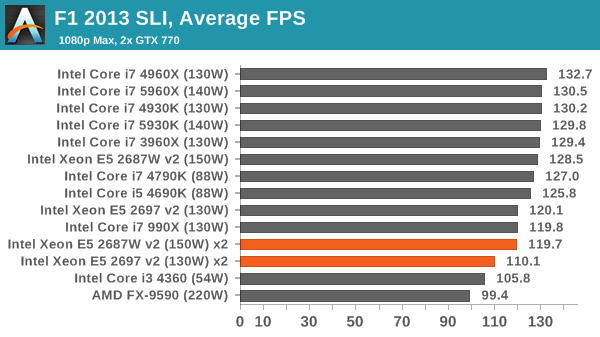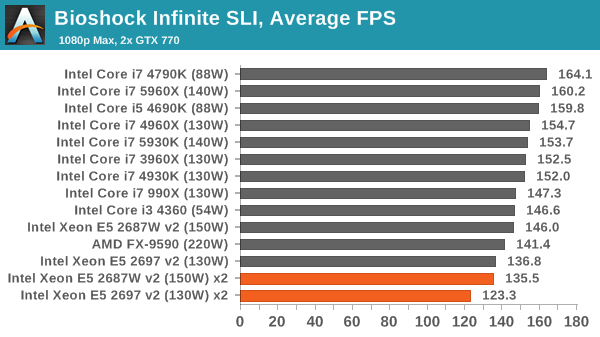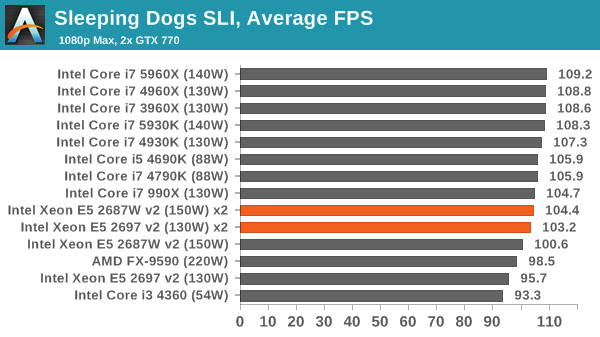GIGABYTE Server GA-7PESH3 Motherboard Review
by Ian Cutress on September 4, 2014 2:00 PM EST- Posted in
- Motherboards
- Intel
- Gigabyte
- Xeon
- Workstation
- Enterprise
- C602
Gaming Benchmarks
While gaming is not a focus of motherboards like the GIGABYTE GA-7PESH3, the system may be in use by content developers relying on an accurate representation with what they are making. GIGABYTE also includes a variety of multiple GPU connectors in the box, indicating that gaming is a use for this system. Gaming on 2P systems is usually restricted by the low single core speed of the processors used, or the memory mismanagement as games are not written to take advantage of a NUMA topology. In fact, our usual Tomb Raider benchmark failed to start at all, suggesting that a 2P system might be wholly engine dependent on what actually works or not. Games that are often heralded as using multiple cores are also usually stumped due to the dual processor nature of the system, causing cross CPU connections to add in extra latency and delays for data.
F1 2013
First up is F1 2013 by Codemasters. I am a big Formula 1 fan in my spare time, and nothing makes me happier than carving up the field in a Caterham, waving to the Red Bulls as I drive by (because I play on easy and take shortcuts). F1 2013 uses the EGO Engine, and like other Codemasters games ends up being very playable on old hardware quite easily. In order to beef up the benchmark a bit, we devised the following scenario for the benchmark mode: one lap of Spa-Francorchamps in the heavy wet, the benchmark follows Jenson Button in the McLaren who starts on the grid in 22nd place, with the field made up of 11 Williams cars, 5 Marussia and 5 Caterham in that order. This puts emphasis on the CPU to handle the AI in the wet, and allows for a good amount of overtaking during the automated benchmark. We test at 1920x1080 on Ultra graphical settings.

F1 2013 typically loves cores and frequency, however there is little gain here over an i3 except for 10-16 FPS in single GPU average frame rates.
Bioshock Infinite
Bioshock Infinite was Zero Punctuation’s Game of the Year for 2013, uses the Unreal Engine 3, and is designed to scale with both cores and graphical prowess. We test the benchmark using the Adrenaline benchmark tool and the Xtreme (1920x1080, Maximum) performance setting, noting down the average frame rates and the minimum frame rates.

Similarly Bioshock Infinite sees the 2P system at the bottom of the pack, especially in minimum frame rates.
Sleeping Dogs
Sleeping Dogs is a benchmarking wet dream – a highly complex benchmark that can bring the toughest setup and high resolutions down into single figures. Having an extreme SSAO setting can do that, but at the right settings Sleeping Dogs is highly playable and enjoyable. We run the basic benchmark program laid out in the Adrenaline benchmark tool, and the Xtreme (1920x1080, Maximum) performance setting, noting down the average frame rates and the minimum frame rates.

The only benchmark where the 2P shines is Sleeping Dogs in minimum frame rates under SLI. Here there is a distinct advantage of having dual processors over a single processor, moving well above 60 FPS minimum. However, the cost for those extra frames makes any other processor seem more palatable.
Battlefield 4
The EA/DICE series that has taken countless hours of my life away is back for another iteration, using the Frostbite 3 engine. AMD is also piling its resources into BF4 with the new Mantle API for developers, designed to cut the time required for the CPU to dispatch commands to the graphical sub-system. For our test we use the in-game benchmarking tools and record the frame time for the first ~70 seconds of the Tashgar single player mission, which is an on-rails generation of and rendering of objects and textures. We test at 1920x1080 at Ultra settings.

Finalising why gaming isn't great on a 2P machine: for Battlefield 4 the i3 scores similar or better than our 2P arrangement.
The end result of the story is: you can game on a dual processor workstation, but it won't be the best experience you can get.














35 Comments
View All Comments
ddriver - Thursday, September 4, 2014 - link
Why include gaming benches, considering this product is not intended nor optimal for the task, while at the same time prosumer and enterprise tests are completely absent?ATC9001 - Thursday, September 4, 2014 - link
The gaming benches are just for good FYI, considering most of the audience are gamers/ enthusiasts. However, I do agree I would like to see more prosumer workload benchmarks!ddriver - Thursday, September 4, 2014 - link
Where is 3D MAX / MAYA 3d rendering? Where is AfterEffects / Premiere / Nuke / Fusion video rendering? Where is Cubase / ProTools / Sonar audio rendering? Where are multiphysics simulations? Where are all the practical workloads that would justify the purchase of a dual socket workstation and that can actually scale up so many cores?Instead we got games, everyday office and multimedia applications and 2 completely impractical synthetic tests. And it is not just that review, this is becoming a common practice at reviewing workstation class mobos. Almost as ridiculous as using different JS engine implementations to measure raw CPU power in mobile devices...
cen - Thursday, September 4, 2014 - link
I completely agree. Anandtech used to have a server division but apparently this is gone now. I have noticed several times that server grade products get non-server related treatment, rendering the whole review completely pointless.xyzzy1954 - Friday, September 5, 2014 - link
I'll second that. I just bought a 'gamer' setup, but for video and audio rendering. I also do a lot of OLAP analytics. I'd really enjoy a review / comparison of 97 to 99 systems for these purposes. Threads matter, RAM > 32 GB matters. I don't get all this hardware from manufacturers for review purposes...so I can't afford to do the comparisons. I feel confident that AnandTech would publish the comparisons if they had all the relevant tests 'off the shelf' (like they already do for game-based testing). Maybe we should crowd source some tests for them....wintermute000 - Saturday, September 6, 2014 - link
yeah I second that. SQL, virt, photoshop, blender, cubase etc. should be the kind of tests not games and office apps!!!!Kevin G - Sunday, September 7, 2014 - link
I personally don't mind the office and gaming benchmarks as they provide continuity between reviews of consumer class hardware. It is irritating is they're the only benchmarks to be had though. A workstation motherboard needs some workstation tests!duttyfoot - Tuesday, September 9, 2014 - link
i feel the same, if you review this type of system you should at least add cinebench along with all the other applications mentioned.MikeMurphy - Wednesday, September 10, 2014 - link
I really enjoyed the gaming benchmarks. I've always wondered how these boards would perform in those circumstances.Samus - Thursday, September 4, 2014 - link
To show this thing is a monster, except when gaming ;)